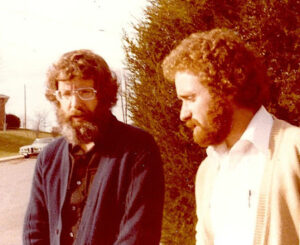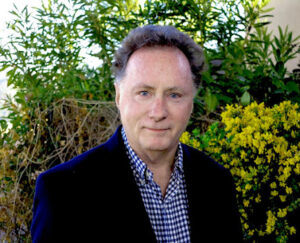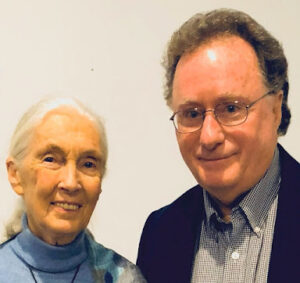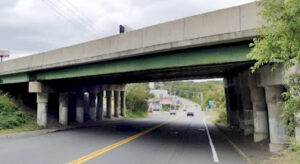1. Introduction to the Founding of IANDS
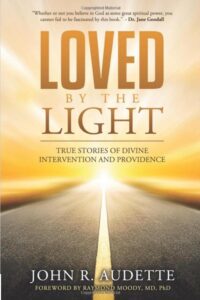
John Audette wrote the following concerning the founding of IANDS and the importance of NDE research:
“The first organizational meeting took place over a weekend in November 1977 at a Holiday Inn in Charlottesville, VA on Saturday and at the University of Virginia on Sunday, the next day. In attendance were Drs. Beverly Belk, Bruce Greyson, Sarah Kreutziger, Raymond Moody, Donald Mueller, Kenneth Ring, and Michael Sabom, as well as Mr. John Egle (publisher of Life After Life and owner of Mockingbird Books at the time), Gina Weiss, M.S., Sue Palmer, myself (John Audette) and a few other interested persons. A subsequent meeting took place at Dr. Moody’s 500-acre farm in Headwaters, VA.
“The agenda for this initial meeting was to formulate a plan to establish an international organization that would serve the interests and needs of individuals who reported having near-death experiences, as well as peak experiences generally, and the researchers who study them, and also to serve as a resource for the general public seeking credible information on the subject. The outcome of this meeting was the formation of the Association for the Scientific Study of Near-Death Phenomena. As far as I know, it was the first organization of its kind in the world devoted to these specific purposes.”
Read more about the founding of IANDS from its founders here:
— The Founding of IANDS by John Audette
— The Founding of IANDS by Raymond Moody
— The Founding of IANDS by Ken Ring
— The Founding of IANDS by Bruce Greyson
2. Without Him, IANDS Would Not Exist
Ah, but a man’s reach should exceed his grasp, Or what’s a heaven for?
— Robert Browning
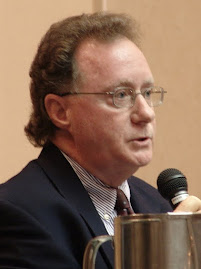
It’s long past time that John should receive public acknowledgment for what he has contributed to our modern understanding of what happens when people enter, at least for a brief moment outside of time, into the vestibule of death, and upon returning to what we call “life,” are never the same. It is my intention in this blog to introduce you to this man to whom we owe so much. So this is John’s story of his spiritual journey that ultimately led to IANDS, but to so much more, as you will soon learn.
John was born in May, 1952, in East Hartford. By a strange coincidence. he was delivered at Saint Francis Hospital, which some years later was one of the three main hospitals where I found my respondents for the research I reported in my first NDE book, Life at Death. When John was four, his family moved to Fort Lauderdale where he grew up, and he currently and for some years has continued to reside in Florida.
I will skip over his early years in order to come soon to the pivotal event in John’s life, but I should mention that after he graduated high school, he served in the U.S. Army during the Vietnamese war, although he did not see combat.
After he returned to civilian life, John found himself at a small college in Augusta, Georgia. He was now a sociology major and soon became president of its Sociology Club. The club would often invite speakers and one of its members suggested her next door neighbor, a medical student named – Raymond Moody. When John inquired what the speaker might talk about, he was told that Moody had been interviewing people who had come close to death and had reported some “mystical experiences.”
When John heard that, he said he “lit up like a Christmas tree.”
Why?
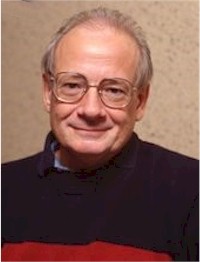
John would later write, when he met Raymond the next day, “I heard the ring of destiny…. I felt then and I still feel today it was the defining moment in my life. It was the single most important event in my personal history.”
It was April, 1974, and John was not quite 22-years-old at the time.
After he heard Raymond’s talk, he cleaved to him like a barnacle. According to John, he and Raymond had “hit it off” on first meeting and felt an immediate liking for each other. John was very eager to help Raymond in his research so he could learn more about what Raymond was now calling “near-death experiences,” and indeed Raymond was happy to have John’s help. When, in November of the following year, Raymond published his groundbreaking book, Life After Life, which would before long become a worldwide best seller, John was thrilled. He already knew what his calling was, his purpose in life, and the tremendous success of Raymond’s book only confirmed that.
But there’s more of this story, and for that, I need to return to what happened to John when he first heard Raymond speak in April, 1974. Here, I can do no better than to let John describe that happened to him that night as he sat listening to Raymond talk about NDEs.
I was in the audience hanging on every word. It was then that I received what I can only describe as “divine inspiration” to form an international association that would harvest and harness the enormous power of these extraordinary experiences to trigger profound individual and social transformation on a global level through the vehicle of science.
I was a self-avowed agnostic at the time, but I was deeply moved by Raymond’s discussion of his research findings … down to the core of my being. I reasoned then, as I do now, that these experiences possess great potential to change human nature and, consequently, the nature of social, political and economic systems, as well as organized religion.
John was on fire, having had his own road to Damascus conversion experience, and although John would never seek to promote himself or endeavor to be the St. Paul of NDEs, he was hopeful that Raymond would support and help him to begin to do the work to transform the world, first by forming the kind of organization that John had envisaged.
But John was soon to be disappointed, the first of many disappointments that he would encounter over the next few years, and indeed for the remainder of his life, as he discovered that for all of his idealistic enthusiasms, few people could bring themselves to share John’s vision for global change based on the findings of NDE research.
Raymond was the first of many eminent researchers and authors to rebuff John.
Surprisingly, from the beginning, Raymond was expressly negative about the association idea. He was he was not fond of organizations and discouraged me from pursuing it. I hounded him through much of 1974-1976 to fully support the idea but to no avail.
Actually, no one who knows Raymond would have been surprised by his lack of interest in John’s proposal to form an international association to further John’s vision. Raymond is definitely not “an organization man.” He is humble, modest, humorous, unpretentious, folksy, gentle – and sweet. He is not ambitious personally or professionally, and has often refused lucrative offers to promote himself. He will leave it to others to try to change the world. Organizations with that avowed purpose would just be an unwelcome distraction for him. He simply wanted to continue to do his research and write his books, which indeed he has done over his long career. So, in short, Raymond turned a deaf ear to John’s repeated exhortations. John was being a pest.
Nevertheless, in the end, Raymond somewhat reluctantly acceded to John’s plea and agreed to host a meeting for some of us early NDE researchers who had ourselves been inspired by Moody’s book.
At that point, John went on the road to hustle us. This is how I came to meet John in 1976 when he came to my home in Connecticut and shared a bit of his plans with me. I liked John immediately, resonated to his ideas, and, said, in effect, “Hell, yes!” John and I seemed to bond at that meeting, which marked the beginning of our more-than-forty-year-long bromance.
Here’s a photo John and me shortly after we met. I was sporting a short-lived beard then, and we both had wild hair!
In November of the next year, John convened the meeting at the University of Virginia in Charlottesville, where Raymond was then located. Raymond served as our genial host and told us – there were about ten of us in attendance, as I recall – that he really wanted to complete his medical studies and was more than happy to “pass the torch” to the rest of us. Figuratively speaking, we grabbed it with alacrity and enthusiasm.
It was at that meeting that John outlined his ideas for an international organization to further the work and spread the word about NDEs, and, in the end, three of us, in addition to John, were in – Bruce Greyson, a psychiatrist, Mike Sabom, a cardiologist, and myself, who was a transpersonal psychologist at the time.
By the following year, “the four amigos” met at a conference – I believe it was in St. Louis – and it was there that we formally established the organization that John had envisioned in what he came to call “his download” in April, 1974, when he first heard Raymond speak. He proposed to call it The Association for the Scientific Study of Near-Death Phenomena, or ASSNDP, for short. He would run it out of his home, which was then in Peoria, and so he did for the next three years.

At that time, “the four amigos” had effectively become three, since Mike Sabom, for the most part, had only a peripheral relationship with IANDS in those early years. But by later in 1981, IANDS was on its way. We organized a big, well-attended conference that year at Yale University, which included some illustrious personages, such as the then prominent Rhode Island Senator, Claiborne Pell, whom I got to know at that time, and one of his friends, a Prince of Liechtenstein.
Since those exciting early years when we were among the first researchers to promote and further the scientific study of NDEs, scores, probably hundreds by now, of physicians, scientists, academics and other scholars have contributed to the development of this field. And these days, the term, first introduced by Raymond Moody, “near-death experiences” (or NDEs), has long entered popular discourse. But it was John’s original vision that really was the inspiration that ultimately led to the development of the field of near-death studies.
However, I need now to turn back to John’s own spiritual journey, which is really the true subject of this blog, as you will see.
John was never really fully happy with the way IANDS evolved. It was still a relatively small organization and never captured the public imagination the way Raymond’s book did. Very few of its board members shared John’s grand vision for how the world could be transformed by knowledge of NDEs and similar transcendent experiences. By 1985, he had left the board and IANDS for good, somewhat disillusioned and definitely disappointed.
He continued to try to find other prominent figures with whom he could collaborate and whom he hoped would share his vision of the potential power of NDEs to have a global impact. One of these was the astronaut, Edgar Mitchell, who became a close friend of John’s, but never really embraced John’s perspective. Similarly, for other worthies – there were quite a few John solicited, including Eben Alexander, who worked with John to establish a new organization, which John called Eternea, and which he still heads. But, like so many before him, Eben had his own books to write and talks to give, so that collaboration, too, ultimately fizzled out, at least from John’s point of view. And, like IANDS, Eternea was never able to secure enough funding for it to realize John’s dreams for it. Another in a seemingly endless series of personal disappointments.
What to do? I had an idea. There was still a way for John to promulgate his vision for a better world based on NDE research and other similar experiences.
John would write a book.
And so he has. It is called Loved by the Light: True Stories of Divine Intervention and Providence. And it is brilliant, stunning, and makes for riveting reading. When I first started to read it in draft form, I was immediately hooked. As I’ve said, I’ve known John for over forty years, but it wasn’t until I read this book that I learned so much about him that I had never known, including that there were at least seven times in his life that, by a kind of miracle, John narrowly escaped death. John thinks it was ‘divine providence” that intervened to save him. Reading his book, I found it hard to disagree. In any case, when you read about these mind-blogging episodes, you will easily understand why John feels that it was really the hand of God that saved him.
His book has already garnered high praise from such well-known writers as Jane Goodall, Caroline Myss and Anita Moorjani, among many others. And Raymond Moody himself contributed a glowing forward, a brief paragraph from which I will reproduce here:
Expect much wisdom to be revealed on these pages, including John’s deeply personal stories about life-saving angel encounters, near-death and shared near-death experiences, bona fide after-death communication, personal sacred epiphanies, as well as several extraordinary events… [John’s book] affirms that God is real and so too is survival of human consciousness after bodily death.
Of course, when it comes to John’s more utopian vision for a global transformation — John’s version of “the impossible dream” -– probably most readers will agree that it can only be understood as aspirational, and not anything that could happen soon in our benighted world. There is no reason to think that in our secular age, the axis of the world would shift as a result of learning about research findings like NDEs since in our own time miracle stories don’t move us as they once might have. More likely, we will just continue to fiddle with our iPhones while the world burns.
John sent me one review that is probably going to be typical about this aspect of John’s book. Here’s just a brief sample of how John’s vision has been dismissed as pure fantasy:
It must be said that Audette probably resides somewhere on the Primrose Path or in the upper reaches of Cloud Nine. He must be terribly naive to genuinely believe that his plan has even a remote chance of succeeding. The odds of the G-20 calling for a global Biblical debt Jubilee to retire all forms of debt world-wide are much better, or the odds of the world’s major religions selling off all their precious jewels, art and real estate to eradicate global poverty.
True enough, but I have another way of understanding John’s vision. It says more about John than it does about the future of our world. In my eyes, John is really a kind of bodhisattva, someone who can’t really be happy until “the last blade of grass is enlightened.” Or, in John’s case, until the world is.
Toward the end of his book, John quotes one of my students who had a very deep NDE. This student told me this: “I wish everyone could have an NDE. It would change the world. Everyone would understand each other and there wouldn’t be chaos, and there wouldn’t be greed or war.” If only…
If only…. Maybe one day in the far future when the world wakes up. Should that day ever come, John Audette’s vision will finally be fulfilled.
To order a copy of John’s book, please go to this link: https://amazon.com/dp/B0BTJWMK8C/
3. The Phantom Hitchhiker
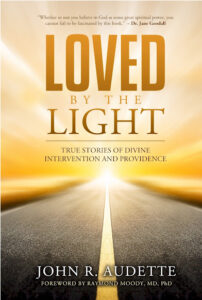
The fourth “angel encounter” in my life took place in April or May 1976 in southwestern Virginia. I was a full-time graduate student at Virginia Polytechnic Institute & State University in Blacksburg. One of my interests in graduate school was thanatology, the studying of death and dying, along with gerontology and medical sociology.
The year before, I had the great pleasure of meeting and befriending Dr. Elisabeth Kubler-Ross, the late prominent Swiss-born psychiatrist who single-handedly revolutionized treatment and care of terminally ill patients in the U.S. and abroad, and who pioneered the hospice movement in the United States and elsewhere. I had read her books and attended several of her workshops and lectures during that time period. I deeply admired and respected her. She was a true original.
One day in March 1976, Elisabeth called to tell me that the she would be flying into the Tri-Cities Regional Airport in Blountville, TN. It was about 130 miles from where I lived at the time, or a little over a two-hour drive. Elisabeth was to be the keynote speaker at a gathering of nurses there. She was also to receive an award for her work.
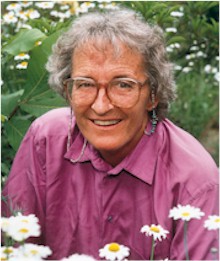
Her plane was due to arrive from O’Hare early in the morning, around 8 a.m. as I recall. This meant I had to set my alarm for 5 a.m. to allow enough time for the drive and other things that needed to be done. The night before, I didn’t get to sleep until after midnight. I had stayed up later than usual to finish a term paper that was due on that very same day.
When the alarm rang, I reached over in my sleep to turn it off. I then started to drift back to sleep once again, but after a few more moments of light dozing, I finally roused myself out of bed. After a quick shower and a quick bowl of cereal, I ran out the door and jumped into my white mist-covered Aston Marina. I headed to my first stop, which was the mail box of a fellow graduate student who had agreed to deliver my term paper to our professor.
It was a foggy morning in rural southwest Virginia and in 1976, street lights were not all that plentiful along Interstate 81, so the highway in front of me was quite dark. Visibility was very limited. I drove along speedily headed southbound, determined to get to the airport on time for the arrival of Elisabeth’s plane. There was hardly any traffic heading south. I mostly had the entire interstate to myself.
After an hour or so of driving, my eyes began to close. Tired from not getting much sleep the night before, I began a dangerous descent into falling asleep at the wheel of my car (yet again). More than a few times, my eyes would close completely and my head would drop, whereupon my car would veer over onto the right shoulder of the interstate. The sound of gravel heading the undercarriage of my vehicle would abruptly awaken me each time. My eyes would open wide and I’d quickly pull back on to the pavement.
This happened several times in fast succession. Each time I’d hear my inner voice warning me to pull over and sleep for a while. But I stubbornly ignored that voice, bound and determined to arrive on time to meet Elisabeth. She was counting on me to arrive on time and I was not about to let her down. She had a tight itinerary during this visit and I was not about to be responsible for getting her off to a late start.
About 50 miles or so from my destination, I could no longer keep my eyes open. I was running off the road with much greater frequency. Once, I almost lost of control of the car as I had a knee jerk reaction and turned too sharply in an effort to bring my car back onto the pavement. It was scary, and I tried everything I could think of to keep myself awake, but to no avail. No matter what I did, my eyes kept closing as I sped down the interstate.
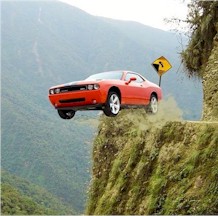
My inner voice grew louder and louder. “Pull over and go to sleep for a half hour or so, dummy, before you kill yourself!” But I kept turning a deaf ear to it. In desperation, I even slapped myself in the face several times in a vain attempt to wake up, but to no avail. My eyes kept closing, even though I sensed that my life was in peril.
I admonished myself. I gave myself stern warnings, thinking I could somehow scold myself into staying awake. “Next time you fall asleep you’re going to run off the road and nose dive into one of these deep ravines down there,” I told myself. You’ll die a horrible, ugly, nasty, gross death in that dark, black void down below and they won’t even find your body, so WAKE UP!”
I fully expected that the next time I fell asleep, it might be permanent. Nevertheless, foolishly, I kept on driving, tenacious as ever about making it to my destination on time. Sensing the hopelessness of my careless attitude, and the immediate prospect of certain death, I believe God then intervened in a supernatural effort to save my life.
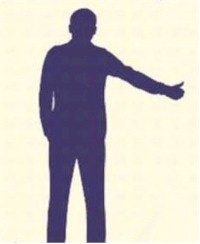
I stopped the car and sat for a moment to absorb what I had just seen. I could hardly believe my eyes. For an instant, I wondered if I was imagining the sudden appearance of this man. I thought to myself, “That guy just materialized out of thin air. What’s he doing out here in the middle of nowhere in the pitch-black dark, hitchhiking?” I mean, there was no one around. No other cars. Nothing but nothingness. He was not even close to an interstate exit. I could not understand how he got way out there in the middle of nowhere. The scene was weird and eerie. In fact, it was surreal, so surreal, I wondered if I was dreaming the whole thing, but I was not.
I wondered whether it was safe to pick this guy up, but then I realized that his company would keep me awake. It occurred to me in no uncertain terms that if I didn’t pick him up, some terrible fate might befall me as I would probably continue falling asleep at the wheel. So, reasoning that I had nothing to lose and everything to gain, I put the car in reverse and backed up to offer this gentleman a ride.
By now, he was running toward my car as I was backing up to meet him. But I did not have to back up very far because surprisingly he was right there already beside my car. I could not figure out how he got up to my car so fast, but in my half-asleep brain-dead state of being, I did not seriously question it or think too much about it.
He came up to my car door on the passenger side. I turned on the dome light and rolled down the window of the passenger door. He politely bent down with one hand on the door and asked if I would give him a lift. I asked him where he was going. He said west to Reno, Nevada. I told him I could take him as far as the exit for the Tri Cities Regional Airport near Johnson City, Tennessee and Abingdon, Virginia. He said that would be fine, so I invited him to step inside.
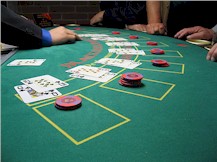
Michael was about 34 or 35 years old; I would guess. He was approximately 5’ 11” and weighed about 175 pounds or so. He had collar length wavy black hair, black eyebrows and piercing soulful brown eyes. He was wearing an all-white suit. Even his shoes were white. All he was carrying with him was a Holy Bible with a black cover. That book was his only possession, no suitcase or shaving kit or duffle bag with a change of clothes, nothing else but a black Holy Bible. Again, very strange.
Michael and I talked and talked, non-stop. We spoke about God, about religion, about good and evil, about forgiveness, as well as social theory and my studies in graduate school. We also spoke about Dr. Elisabeth Kubler-Ross and her work. The conversation was enlivening.
Suddenly, I became wide awake. The sleep that had clouded me earlier was gone, long gone. Michael’s company was invigorating and strangely comforting, like I was having a reunion with an old friend. His company quickly put an end to the driving equivalent of Russian roulette that had overtaken me in my drowsiness behind the wheel only minutes before.
We had driven for more than an hour together, but it seemed timeless. As I looked into his eyes, I felt deep recognition, almost at the soul level, like we had met before, or like I knew him from some other place, perhaps some other time. I remember wondering if he could be an angel sent to save me, but it was just a passing thought at the time.
Soon, the sun rose and the new day had begun. Before I knew it, we arrived at the exit for the airport. I liked Michael and was not ready to say good-bye. So, I invited him to join me in meeting and greeting Elisabeth. Politely and graciously he said, “No thanks. I don’t think that’s going to work out.” I thought who in their right mind would turn down an opportunity to meet Dr. Elisabeth Kubler-Ross at the height of her fame and popularity? Well, Michael did. I was about to find out why.
Just before the exit, I pulled off onto the shoulder of the road and stopped the car momentarily. I asked Michael for his address and told him I would write him in a month or so to find out how his trip to Reno, Nevada turned out. He obliged and wrote down his name and address. He handed me the paper with his address on it. I placed it in the glove box of my car. I wished him lots of luck. We shook hands and said goodbye. I pulled away and headed up onto the exit ramp, watching Michael in the rear-view mirror for part of the time, feeling grateful for his company which clearly kept me from meeting with certain catastrophe.
As I turned left onto the overpass from the exit ramp, I lost sight of the place where Michael was standing, but only for a few moments. When that spot came into my view again just a minute or so later, Michael was gone. He was nowhere in sight. He could not have walked to under the overpass so quickly. It was too far away from where he was standing to have walked or run there in the short time that he was out of my sight. And no other car could have picked him up so quickly without me catching a glimpse of it. He had to be around there somewhere, but he was nowhere to be found.
I drove slowly along the overpass looking for Michael. I surveyed the median and the shoulder of the interstate, up and down, through and through, but he was nowhere in sight. As I searched around for Michael to discern where he might have gone, I did not see any place for him to go except to keep walking straight ahead along the shoulder of the road toward the overpass.
Puzzled by Michael’s sudden disappearance, I made a mental note to write him as soon as I returned to Blacksburg, where I lived at the time, to inquire as to where he went once I drove away from him. I then parked my car in the airport parking lot and proceeded into the terminal. Once inside I quickly made my way to the gate designated for Elisabeth’s arriving flight. I arrived there ten minutes or so before the plane pulled in to the gate, right on time.
All of the deplaning passengers strolled by me, every single one of them except Elisabeth. Then the procession stopped. A few moments later, the flight crew came walking through. I asked if any other passengers were on board. They said there were none. I went to the ticket counter for the airline she was supposed to have flown and asked them to page her. The nice lady at the ticket counter obliged by paging her three times for me, but all was for naught. A supervisor then returned from break, and said “Are you Mr. Audette?” How did she know my name? I wondered. “Yes, that’s me,” I replied. She said Dr. Kubler-Ross had called earlier and left a message for me. I was to call her at home.
I changed dollars for quarters, and then made a long-distance call to Elisabeth from a nearby pay phone inside the terminal. Elisabeth was at her home in Flossmoor, Illinois. She was home sick in bed. She had taken ill at the last minute and could not make the trip. She canceled her flight and her appearance. She had tried to reach me too at my home, but apparently sometime after I had begun my journey to pick her up at the airport. She apologized to me and, of course, I said no apology was needed. I then wished for her a speedy return to perfect health and said good-bye.
As I walked through the terminal on my way back to the car, I stopped in the gift shop to buy a post-card to mail immediately for Michael. Now my mind was really racing. “How did he know that this was not going to work out before I knew it was not going to work out?” I asked myself. “Who was that guy?” I wondered.

As quickly as Michael had appeared, he disappeared. As quickly as the paper with his address appeared, it too disappeared. “This is really strange,” I thought. Could he have been another guardian angel sent by God to keep me from dying before my time? I think so. No other explanation makes any sense to me.


